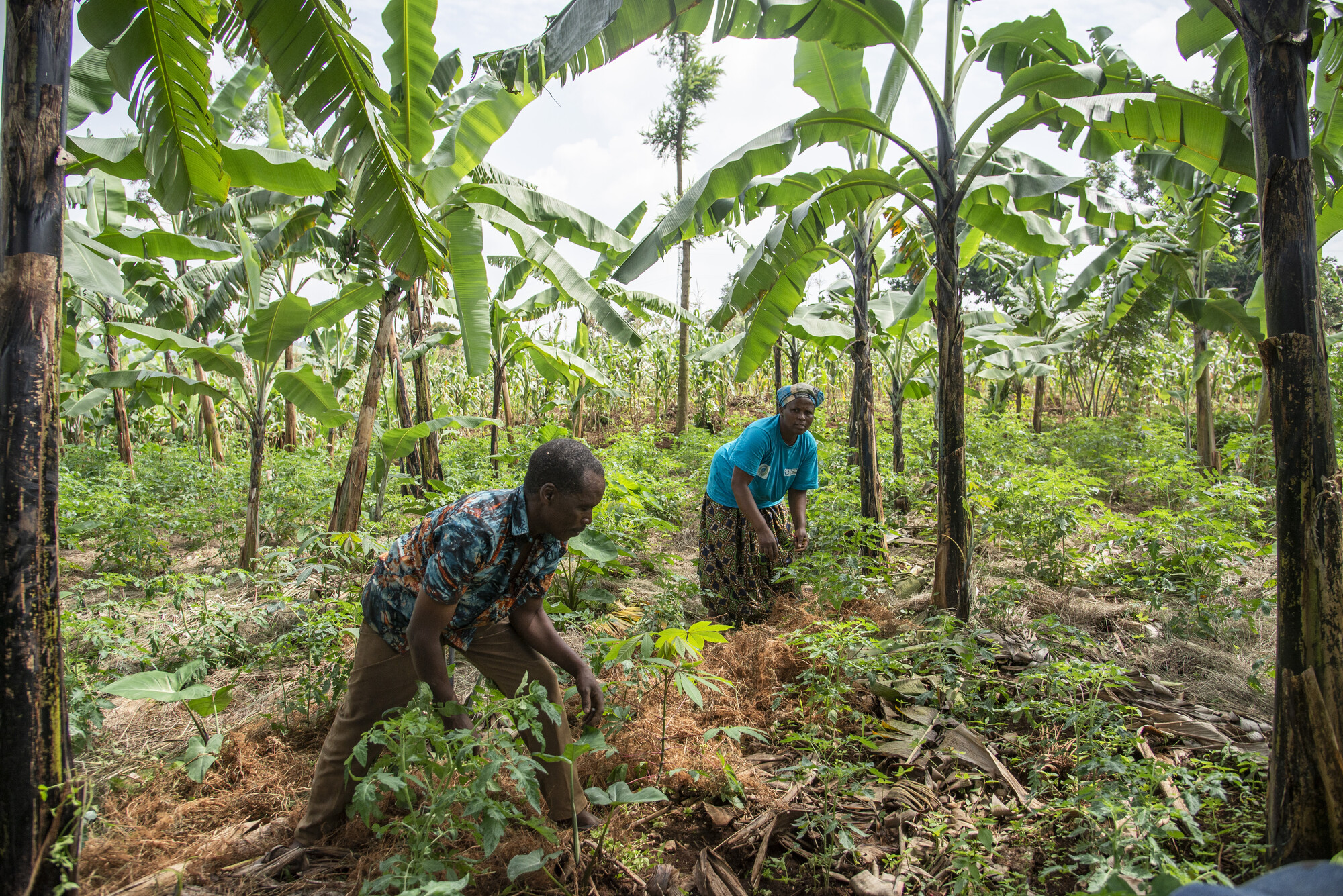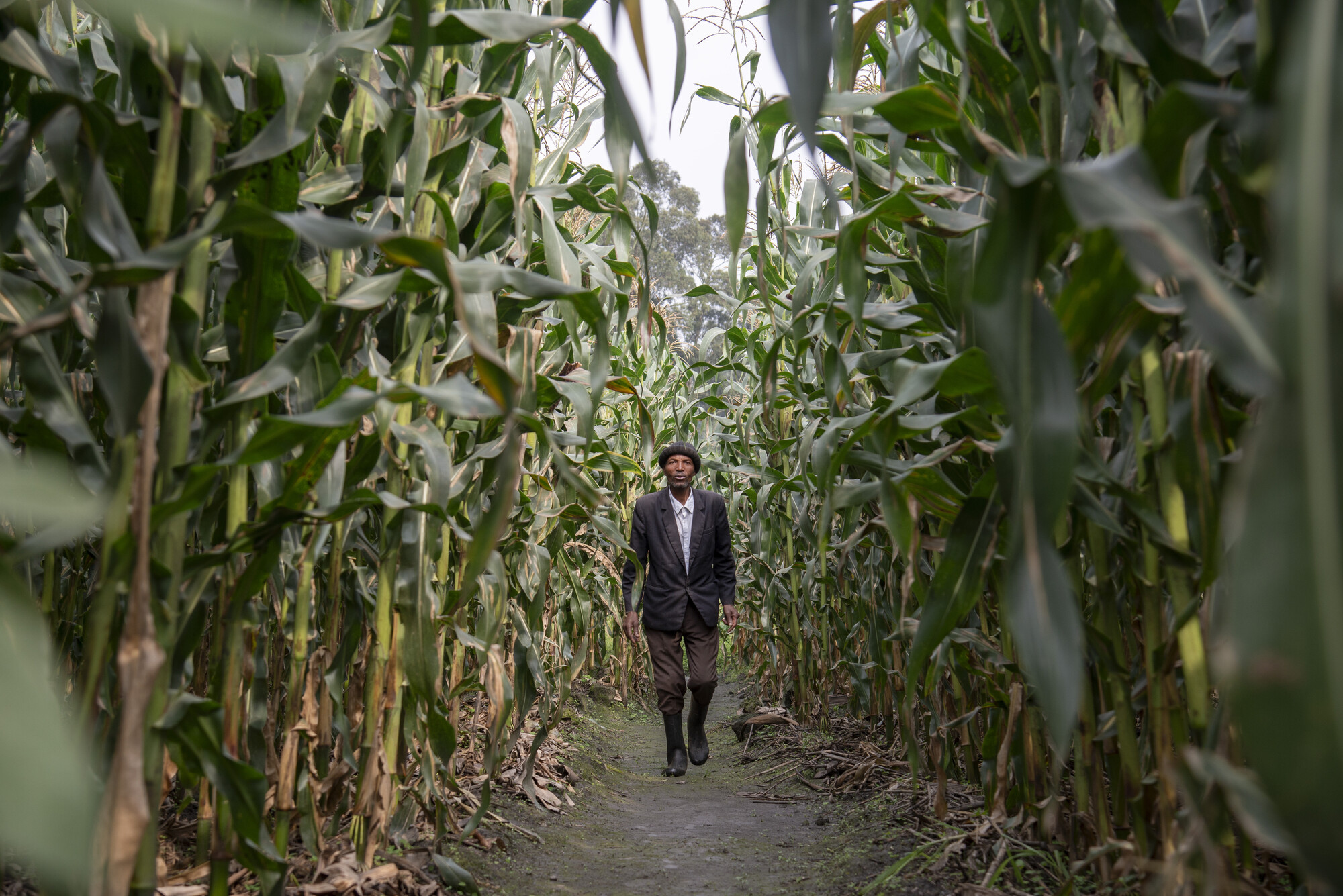When communities grow together
With guidance from an MCC partner, Rwandan farmers are improving their yields — and their relationships with each other — through conservation agriculture.

Jean Bosco Nsanzimana was used to getting food from the market — “even though I was a farmer,” he says.
Practices like intensive tilling had left his land, in the Kayonza District of Rwanda’s Eastern Province, depleted and unable to produce much food. And in this region of Rwanda — hotter and lower-lying than much of the country — changing weather patterns have brought additional challenges.
“We face the issue of climate change," Nsanzimana says. There are times of drought, which destroy crops and lead to hunger. “Or sometimes there is a lot of rain which destroys plants on the farm.”
The cloud-kissed highlands to the north of the country have also experienced erratic, and increasingly heavy, rainfall. “This period used to be sunny, but seasons have changed,” observes farmer Vincent Hategekimana on a drizzly January day in Northern Province’s Burera District. The rain has changed the planting and harvesting schedule that he and his wife, Verena Nyirantezimana, followed for years.
"We face the issue of climate change."
Jean Bosco Nsanzimana
Hategekimana gestures to a damp heap of beans in their courtyard. “If it was sunny, we could be grinding these beans, however, we can’t because they are not yet fully dry for today.” Downpours can even bring destructive landslides that can carry away months’ worth of work in minutes.
Conservation agriculture training, provided through MCC partner Peace and Development Network (PDN), is helping these farmers, and others throughout Rwanda, find steadiness amid the uncertainty that climate change brings.
Now, when growing conditions are right, these farmers can grow enough to sustain their families, with extra to sell. Even when conditions are subpar, farmers who follow conservation agriculture practices get at least some crops, whereas neighboring farms may not harvest anything.
The techniques also stabilize the soil, helping to prevent erosion and landslides.

Since 2015, PDN has collaborated with MCC and Canadian Foodgrains Bank to help conservation agriculture take root in the country.
PDN is a network of five organizations from different parts of Rwanda. Each formed in the years following the 1994 genocide against the Tutsi, seeking to foster unity. As ethnic tensions defused, PDN saw that poverty and food insecurity were becoming the main sources of conflict in the country.
PDN and its member organizations teach farmers the three principles of conservation agriculture: to till the land as little as possible, to keep the ground covered in mulch or cover crops, and to alternate the types of crops grown on their land. Farmers switch between cash crops like potatoes and nitrogen-fixing legumes like velvet beans, and give land time to lie fallow and restore itself. PDN’s member organizations also distribute livestock so that farmers have access to manure.
To help these practices spread, PDN establishes farmer field schools of 30 farmers and provides each school with a communal practice plot. After the harvest, each member can take a share of the produce home, and the rest is sold. The farmers decide together how to use the proceeds. Participating farmers are then expected to apply the new practices to their own land and to teach the techniques to five other farmers.
We started realizing that the method works.
Jean Bosco Nsanzimana
As Rwanda is one of the smallest countries on the African mainland, most farmers look to maximize yields on small plots. Conventional agriculture has been the norm for so long that some techniques, like leaving land fallow, can feel counterintuitive for increasing productivity. Nsanzimana learned conservation agriculture techniques from PDN member Collectif des Artisans de Paix et la Reconciliation (CAPR; Collective of Peace and Reconciliation Builders), which operates in Eastern Province. He admits that when a farmer field school came to his community, he was skeptical and joined, “but with dragging feet.”
He recalls that after a short while, “We saw how plants were growing. . . . We started realizing that the method works.” PDN staff note that crops grown following conservation agriculture are greener, fuller, taller and more likely to withstand droughts and heavy rain. Nsanzimana observes that his maize yields have increased tenfold.
And, through PDN, support was close at hand, he says. Farmers can approach field staff from their local PDN member organization with questions on conservation agriculture, and they have access to veterinarians who can offer advice on livestock.
In the communities it serves, PDN also establishes village savings and loan associations. These allow farmers to save money, accrue interest and obtain loans. Participants have been able to build and repair their homes, purchase large livestock like cows and pay for their children’s tuition. Those who once rented farmland often use the money to buy property.

And farmers can withdraw or borrow the money their families need to survive. “When there are effects of climate change and crops are destroyed, we can get a loan . . . to solve any issue at that moment,” says Jeanne Francoise Maniragena, who lives in Northern Province and is secretary of her association.
The goal is that farmers don’t just live in harmony with the land, but also with each other. Anastase Nduwayezu, assistant project coordinator with PDN, explains that scarcity can lead to discord, but also, “When there’s a good harvest, sometimes there is conflict in the house related to how they manage the yield.” In response, the five organizations offer trainings on topics like conflict resolution and gender equality.
Before attending these trainings, Hategekimana recalls, “I would make decisions on my own. I would decide what and where to cultivate. I would decide to plant beans whereas she wanted potatoes.” Nyirantezimana adds, “We would do it in disarray and it was not giving us any result.”
"The future of agriculture is bright."
Marie Mukamana
The trainings taught them how to make decisions about the farm together, which has transformed both the health of their crops and their relationship. “I cannot do it alone, neither can she,” Hategekimana says. “We complete each other.”
Other farmers, like Marie Mukamana of Kayonza, have used what they learned to help neighbors mediate disagreements. “If I had never been trained in conflict resolution among families, I would not be able to help. I would help myself.” But the trainings equipped her with a sense of duty to help others, and with the skills to do so.
Staff hope that one day, the techniques will spread nationwide. Those in farmer field schools are likewise thinking of the future. Five of Mukamana’s six sons are farmers, and she envisions a day that they, along with other community members, all experience the benefits of conservation agriculture.
“The future of agriculture is bright,” she says.
Sienna Malik is managing editor of A Common Place magazine. Denyse Kamugwiza Uwera, a freelance photographer in Rwanda, supplied photographs through Fairpicture.
Header photo caption: Jean Bosco Nsanzimana and his wife Chantal Nyiramvuyekure work together to mulch tomatoes and banana plants, all cultivated using conservation agriculture methods. MCC/Fairpicture photo/Denyse Kamugwiza Uwera
Give where needed most
Every donation makes a difference.

